Let’s explore morphology in structured literacy today.
Be sure to follow along with our What is Structured Literacy? blog series!
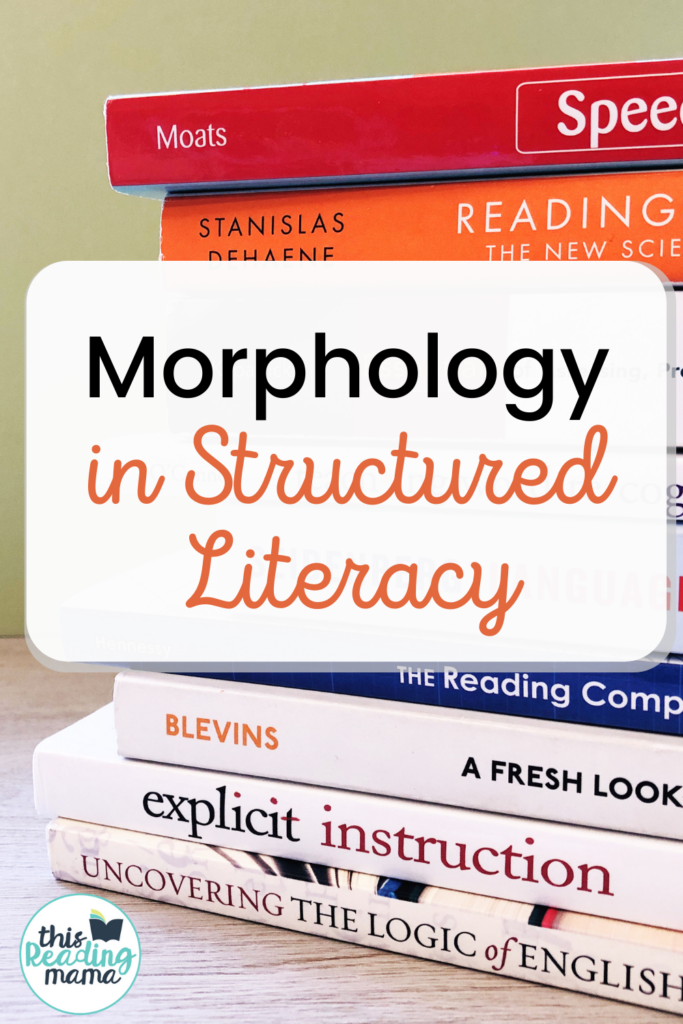
What is Morphology?
Morphology refers to studying the morphemes {or units of meaning} in words.
It’s clear as day now, right? Ha! Let’s make it a little clearer.
A morpheme is the smallest unit of meaning in a word. For example, the prefix un is a two-letter morpheme that carries the meaning of “not.” The suffix s can carry the meaning of more than one object {plural.}
At their most basic level, morphemes can be free or bound.
Free morphemes can stand alone as whole words. Chair would be a free morpheme. So is the. Bound morphemes cannot stand alone as whole words. Prefixes and suffixes {like un, dis, or est} would be simple examples of bound morphemes.
*I am a participant in the Amazon Services LLC Associates Program, an affiliate advertising program designed to provide a means for me to earn fees by linking to Amazon.com and affiliated sites.
Why Does It Matter?
To keep this post from being way too long, here’s the basic gist of why teaching morphology is important: It helps our learners to 1- understand why we use certain verb tenses in oral language, 2- read with meaning, and 3- spell words.
One Quick Example:
Let’s say Toni wants to write, “The dogs are big.” She writes, “THE DOGZ ARE BIG,” instead.
If Toni understood the meaning of suffix s, she could have had this conversation with herself while writing: “Hmmm…it sounds like dog has a z on the end. But I know that I’m writing about more than one dog. I need to add an s to the end of the word when I’m writing about more than one dog.”
The same can be said of suffix ed when it sounds like /d/ or /t/. Often, you’ll find learners spelling JUMPT instead of jumped. They don’t quite understand the morphology of the word parts just yet.
While morphology is often associated with the older grades as we teach prefixes, suffixes, and Latin and Greek roots, Moats says in her book, Speech to Print, “morphological awareness is associated with reading and spelling growth from first grade onward.”
Morphology in Structured Literacy
As with all things structured literacy, we want our teaching to be:
- Explicit – We are direct in how we teach the units of meaning {or morphemes}.
- Systematic – Our teaching is organized in a logical way that helps our learners understand the concepts.
- Cumulative – Our teaching constantly mixes in review concepts that have been learned previously.
- Diagnostic/Responsive – We use what we observe about our learners to guide our teaching.
Let me share an example and non-example with each kind of teaching.
1. Explicit Teaching with Morphology
Explicit teaching means that we teach in a way that leaves nothing up to “chance.” We don’t just hope that our kids will get it; we teach so they can easily get it.
With explicit syllable instruction, we show our learners exactly how to break apart a word based on its morphology {meaning units}.
Example:
- Write ask for learners to see.
- “We’ve been working on closed syllable words. Would you say that this word is a closed syllable word?” {Learners answer.} “Yes. It has one vowel, an a, with two consonants closing it in. This word has an s and a k closing in the a.” {Point to ask.}
- “We know the vowel will make the short sound like apple. So we can read the word starting at the a…ask.”
- “Today, we’re going to add a special ending, called a suffix, onto ask to create a longer word.”
- Write ing behind ask for learners to see. Box in the suffix to draw attention to it.
- “This is the suffix _ing. We can add it to the end of words to show that we’re doing something right now, in the present. The longer word I made is ask – ing, asking.“
- “Listen as I use the word in a sentence: I am asking a question. Notice, I used ing to show you that I’m asking you right now.”
- “Can anyone else use the word asking in a sentence?” {Ask for volunteers.}
- “Did you also notice that the _ing added a syllable onto the word?”
- Cover ing. “Let’s clap and count the syllables of the word ask.” {Clap and count.} Uncover ing. “Now, let’s clap and count the syllables in asking.” {Clap and count.}
- “Let’s try adding ing to the end of other closed syllable words you already know.”
Non-Example:
- “We can add ing onto words to make them longer. Look at how I add ing to these words. Examples: asking, telling, chatting, fixing.
- “Let’s read these words together, listening for the ing chunk at the end.”
The example lesson I’ve scripted above provides a clear-cut and explicit model in which learners are told 1- ing is a suffix, 2- where to write it onto words, 3- why it’s used, and 4- how it changes the words’ meanings and syllable counts.
In the non-example, there’s no model of how to do it. There’s no explicit definition of what ing is or why it’s used at the end of words.
2. Systematic Teaching with Morphology
Systematic teaching means that we teach syllables in a logical, organized order. It’s not sporadic or random. In order to do this, we need to understand which morphemes need to be taught first.
Generally speaking, this means we start with the more common morphemes and move to the less common/harder morphemes.
As you add more and more morphemes, practice building words with these morphemes. For example, what words can you make with read, re, ing, & s? {Answer: reading, reread, rereading, reads.}
Example List:
- Start with adding inflected endings to one-syllable words learners already know how to read. These include _ing, _ed, _s, _es, _er, or _est.
- Integrate common prefixes into known base words learners already know. Examples: un, re, or dis
- Move to lesson common prefixes such as ex, ante, or a and less common suffixes such as _en, ish, or ity.
- Move to Greek Roots and Latin Stems such as ject, graph, or trans
Non-Example:
- “Last week, we read words with ing on the end.”
- “Today, we’re going to learn about a suffix you won’t see very often, but I still think it’s important that we learn about it…”
In the example list above, teaching morphemes follows a logical sequence from common to less common.
In the non-example, there is no pattern. One day you’re teaching a common suffix; the next day, the teacher is introducing an uncommon suffix.
3. Cumulative Teaching with Morphology
Cumulative teaching means we mix in review concepts and help our learners see how what they already know can be used to learn something new.
Example:
The example I shared under “Explicit teaching” also mixes in cumulative teaching.
In that lesson, learners are seeing how they can apply what they already know about closed syllable words as well as syllable counting and apply those to the new concept.
Non-Example:
- Teaching new concepts that do not integrate review and/or do not build on what learners have already learned.
FREE Multi-Syllable Word Resources
4. Diagnostic Teaching with Morphology
Diagnostic teaching {or responsive teaching} means we are teaching in the zone of what our kids need to know to continue growing in their learning. We honestly can’t know this if we aren’t observing what they know/don’t know in every day discussions or their independent work.
Examples:
- Asking questions such as, “How did you know which part was the base word and which part was the suffix?”
- Listening to learners’ responses to the questions you ask and the discussions you have.
- Observing the kinds of morphemes learners misuse or use correctly in speech.
- Using a child’s writing or work as a “window” in which to see what they do or don’t yet understand about morphemes and basing your teaching off of that information.
- Creating small groups for learners who need more instruction on morphology.
Non-Examples:
- Grading work to get it done, not noting the mistakes learners are making related to your teaching. {SO easy to do!}
- Moving on to teaching more morphemes because it’s in your curriculum despite what you observe in your learners.
Final Thoughts
Once again, I’ll shout this from the rooftops: morphology instruction within the frame work of structured literacy ISN’T just for struggling readers. ALL of our readers can benefit from teaching it explicitly, systematically, cumulatively, and diagnostically.
Enjoy teaching!
~Becky
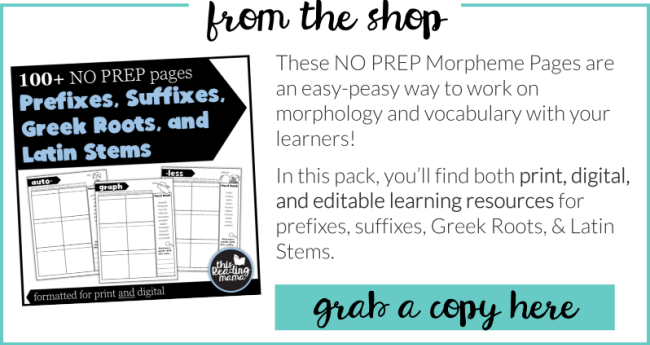
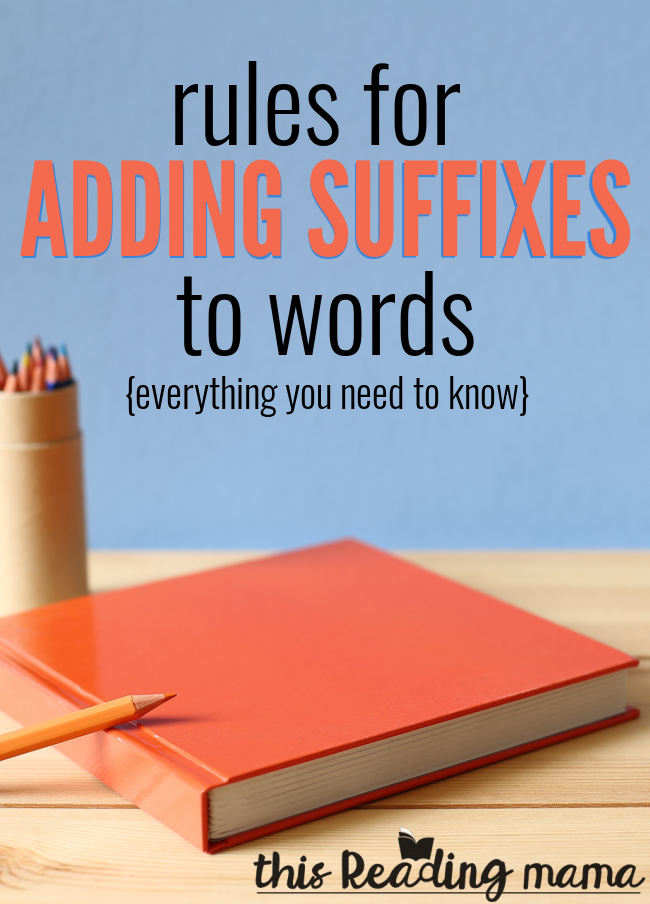
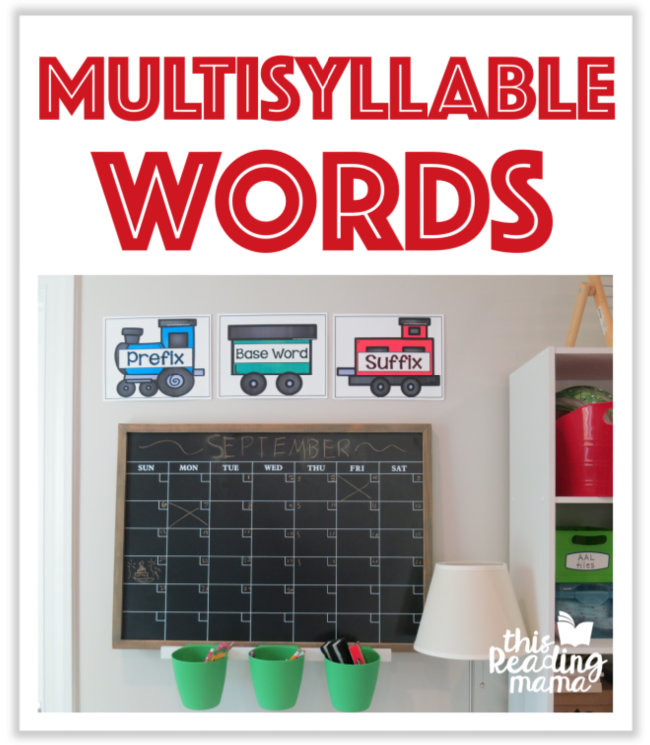
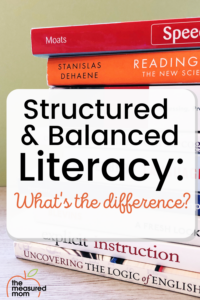
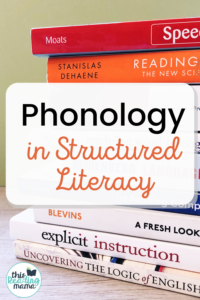
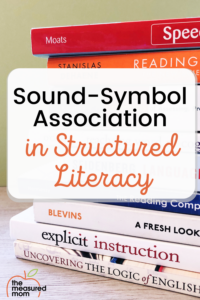
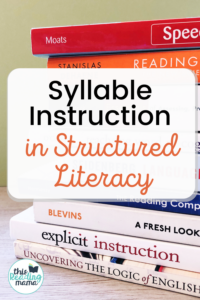
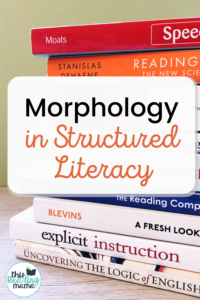
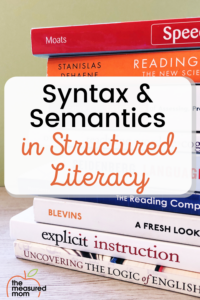
Leave a Reply